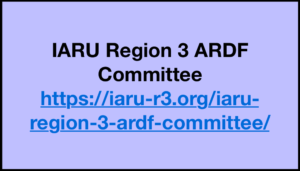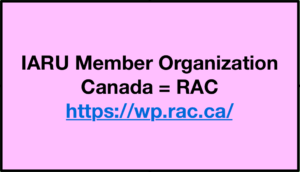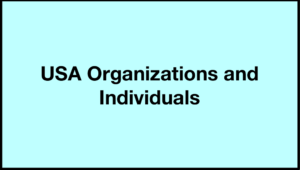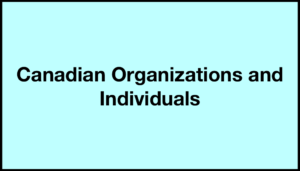This blog entry was updated in March 2023.
Below is a diagram depicting the current way that ARDF is administered with a focus on Region 2. The diagram is intended to show all the entities responsible for how ARDF is defined, practiced or promoted in IARU Region 2. The lines between the various entities imply the type of relationship or interaction between them.
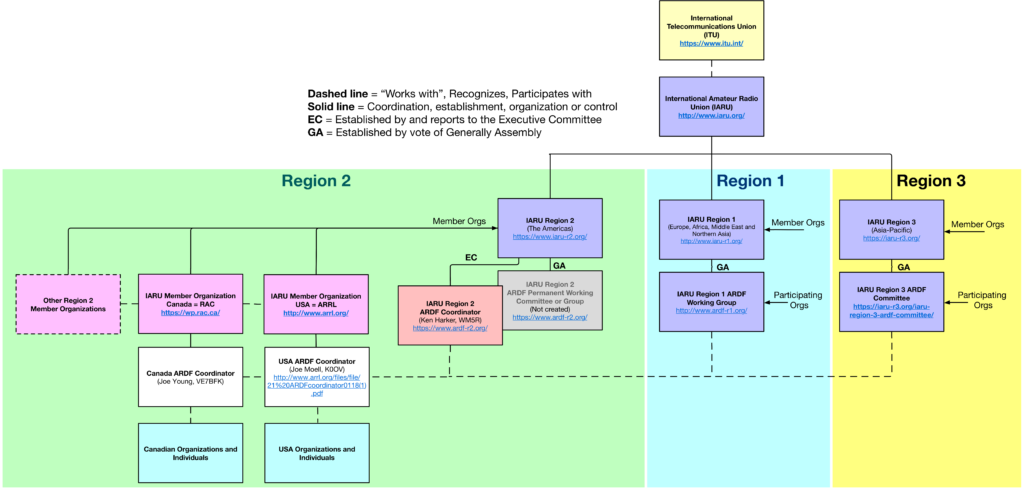
The intent of the diagram is to depict diagrammatically the current ARDF-related entities and their relationship to one another. Their roles and responsibilities are discussed below.
ITU & IARU
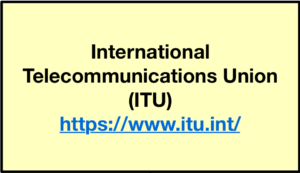
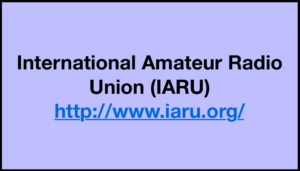
If we focus on the sport of ARDF, the ITU and the top level of the IARU have no direct influence on the sport. Radio sports are not specifically mentioned in their constitutions or bylaws and are not managed at that level. The ITU and IARU are included in the diagram only to complete the “big picture”.
IARU Regions
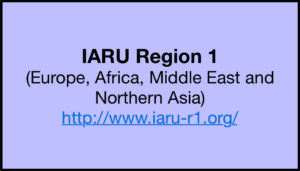
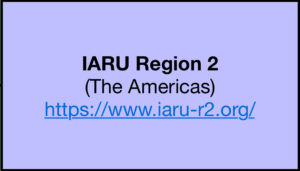
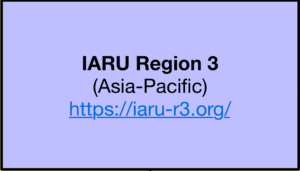
IARU Regions are autonomous and operate in accordance with their own Constitution. Their members are comprised of national societies representing each region’s member countries. See ARRL IARU.
The IARU regional organizations are at the top of the ARDF hierarchy, in that they have responsibility for defining, supporting, and managing the sport. Having three autonomous organizations all managing ARDF from the top could lead to divergence in how the sport is played and organized around the world. Such divergence could be beneficial by allowing the regions to customize ARDF to maximize interest among their member societies. But too much divergence would be detrimental if it were to result in three separate incompatible sports. Fortunately, the regions have insisted on making inter-regional coordination a priority.
IARU regional organizations are not obligated to recognize ARDF at all. The autonomous regions are free to address the needs of their regional membership as appropriate to fulfill their missions. If ARDF plays an insignificant role in a particular region, and the member societies consider it unimportant, a region need not support it in any fashion. That was the case in IARU Region 2 until about seventeen years ago.
In September 2001 IARU Region 2 approved Standard Operating Procedures (SOP) that recognized the sport of ARDF in the region:
ARDF, the activity. Amateur Radio Direction Finding is a technical, sport activity within the framework of the amateur radio service. It deals with the taking of radio bearings and finding hidden transmitters, constructing direction-finding equipment, and the training of amateurs involved in and with the organizing of relevant sport and social events.
IARU Region 2 ARDF Coordinator
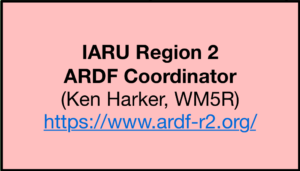
In the same September 2001 Standard Operating Procedures, IARU Region 2 defined a new role: IARU Region 2 ARDF Coordinator. That role was created as a “special advisory committee” by the Executive Committee (EC) and reports directly to the EC.
The Region 2 ARDF Coordinator was assigned duties related to investigating the popularity of the sport in the region, keeping track of ARDF activities in the other regions, and reporting back to the Executive Committee with findings and recommendations:
ARDF Coordinator Duties.
(a) The Region 2 ARDF Coordinator shall become aware of, and shall encourage and support, ARDF activities within Region 2 and shall report on such activities from time to time to the Region 2 Executive Committee.
(b) The Region 2 ARDF Coordinator shall, in general, be aware of ARDF activities in IARU regions 1 and 3 and shall report on such activities from time to time to the Region 2 Executive Committee. The Region 2 ARDF Coordinator shall also cooperate with the ARDF coordinators from Regions 1 and 3 for the purpose of promoting ARDF activities worldwide.
(c) The Region 2 ARDF Coordinator shall make any such recommendations as are reasonably necessary and appropriate to the Region 2 Executive Committee to promote ARDF activities within Region 2.
ARDF Working Groups & Permanent Committees
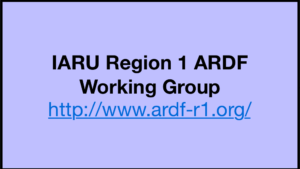
The creation of an IARU Region 2 ARDF Coordinator position was a significant step forward, but still left ARDF’s stature in Region 2 in a very different state from other regions. IARU Regions 1 and 3, where ARDF is more established and widespread, have established ARDF working groups or permanent committees by resolutions passed by the Member Societies at regional General Assemblies (GA).
The responsibilities of those groups are described by IARU Region 1 ARDF Working Group to include:
1. To disseminate information related to ARDF.
2. To develop ARDF materials and answer questions from other IARU bodies.
3. To provide ARDF advice and help to IARU Member Societies, to prepare bulletins and educational material, to assist the IARU Regional Member Societies in ARDF activities.
4. To submit ARDF advice, proposals, and recommendations to the Executive Committee.
5. To participate in the organization of IARU ARDF events.
6. To undertake ARDF activities on behalf of the IARU Region.
7. To organize IARU international events and championships.
8. To support sport and technical progress in ARDF.
9. To prepare the ARDF competition rules.
10. To provide for skilled referees serving at International, Regional and World Championships.
11. To cooperate with similar bodies in other IARU regions that promote and administer the sport, helping promulgate and standardize the sport throughout the regions, and coordinating ARDF activities between the regions.
ARDF’s disparity between Region 2 and the other two regions remains to this day. Unless the Region 2 Organization can be persuaded otherwise, this situation might not change so long as the sport is isolated to only a small number of Region 2 countries.
In the absence of an entity tasked with administering the sport at the regional level, the responsibilities above are not officially supported by Region 2. Instead, ARDF coordination and administrative responsibilities fall to the member societies and individuals, where they are addressed on an ad hoc basis if they are addressed at all.
The creation of a Permanent ARDF Working Committee for Region 2 would require passage of establishment legislation (a resolution) at a Region 2 General Assembly. Region 2 General Assemblies are triennial events, with the next one scheduled to occur in 2019 at Radio Club Peruano in Lima, Peru. The resolution to create a Region 2 ARDF Working Committee would need to be sponsored by one or more Region 2 Member Societies.
IARU Member Organizations (Member Societies)
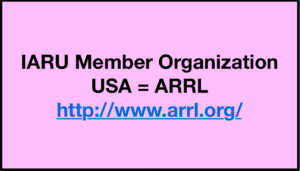
The members of the IARU Regional organizations are those societies of radio amateurs situated within Region 2 that are members of the International Amateur Radio Union. The IARU Constitution states that there shall be only one Member-Society representing a country or separate territory.
Radio Amateurs of Canada (RAC) is the member organization representing Canada.
The American Radio Relay League (ARRL) is the member organization representing the USA. The ARRL is a member of IARU Region 3 as well as Region 2 because it represents the radio amateurs of Guam, the Northern Marianas and American Samoa which are located in Region 3.
In Regions 1 and 3 where ARDF is the responsibility of working groups or committees comprised of representatives of member societies, those member societies retain at least the following ARDF-related responsibilities:
1. Maintain their full membership in a regional IARU organization.
2. Assign a society representative to the ARDF Permanent Working Committee or Working Group.
3. Delegate single competitors or teams to participate in intra-regional competitions.
4. When authorized by its corresponding IARU regional organization it may organize a World Championship.
5. When authorized by its corresponding IARU regional organization it may organize a Regional Championship. A Regional ARDF Championship is the event to award the title of Regional Champion in ARDF.
In Region 2, there are no specific ARDF responsibilities nor authority assigned to the member societies. So the ARRL is able to exercise the authority afforded by other regions to member societies from outside those regions. Within the borders of the USA the ARRL is authorized and constrained by its own Articles of Association, Bylaws and internal policies, and by a desire to best serve its membership and cooperate with its fellow societies within and outside Region 2.
USA ARDF Coordinator
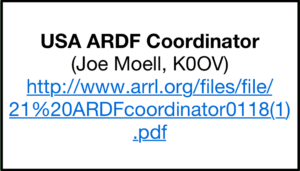
In June 1999 the ARRL established the position of USA ARDF Coordinator and assigned Joe Moell, KØOV to fill it. The ARRL does not have an ARDF Department to track ARDF activities in the USA, to vote on who should comprise the national team, or organize regional or world championship events. There are no ARDF sports experts at the ARRL to write copy for announcements, USA championship results, or team USA results at the World Championships. All that and a whole lot more falls to Joe Moell and one new member of the ARRL’s ARDF committee. (Correct me if I’m wrong, Joe or Jerry!)
The purpose of the USA ARDF Coordinator position, according to the Report to the ARRL Board of Directors, January 2018 is: “to promote the development of this sport within the country and to work with ARDF Coordinators of other IARU countries to organize ARDF events and activities. The focus is on international-rules on-foot foxhunting (also called foxtailing and radio-orienteering), but not mobile hidden transmitter hunting.”
Local Organizations and Individuals
The folks participating in ARDF activities, and the clubs and groups that directly support them are the grassroots of the sport. Collectively they hold ultimate control over the sport, for without them there would be no ARDF activity to manage.
What Might Be Falling Through the Cracks?
The amount of work and responsibility assigned to the USA ARDF Coordinator might be manageable for a few very talented and industrious persons. And with ARDF activity isolated to so few countries in our region, there might be little need for coordination amongst member organizations. But perhaps there are important issues that are not being addressed, and which might be slowing ARDF’s growth and even risking the sport’s future.
In ARDF’s current state in Region 2, the ARRL, local clubs, and individuals have a significant interest in investigating and addressing concerns affecting their IARU region. But without direction and coordination at the Region-2 level, it might be difficult to prioritize the issues and coordinate efforts to effectively address regional concerns:
- How should ARDF be promoted in Region 2? Who should be responsible for promoting the sport and identifying promotional opportunities? How should the effectiveness of promotional efforts be measured and reported?
- What factors are holding ARDF back from becoming more popular in our region? What can be done to increase ARDF’s popularity? Who is responsible for implementing needed changes?
- How can more women and youth be brought into the sport?
- Might our region benefit from an official web-based “one-stop shop” of information for “all things ARDF” in our region? Who would maintain it?
- Would an ARDF rule set specific to Region 2 be more effective for our region? Who would create it? Who would approve it? How would it be maintained? How would it be coordinated with the rules of other regions?
- Could ARDF instruction be made more accessible and higher quality? Should there be a training program for ARDF instructors? Should there be a program for certifying ARDF instructors? Who would implement it? How would it work?
- Should there be a well-equipped and maintained equipment pool made available to sanctioned event organizers? How could that be brought about?
- How are we measuring ARDF’s growth and progress in Region 2? What is the best way to measure it? Who should be responsible for gathering, compiling, and disseminating the data? Who would be responsible for acting on what it reveals?
- How can ARDF equipment costs be brought down? How can equipment availability be improved? How can equipment reliability be improved?
- Is cheating a problem in the sport? What should be done to address it? Who is responsible for addressing it? How do we coordinate our efforts with other regions?
- Are we developing skilled referees in our region? What should be the qualification of a referee? Should referees be trained and certified? How do we coordinate these efforts with other regions?
You Are ARDF in Region 2
Though their number remains relatively small, ARDF enthusiasts in Region 2 include enough individual talent to fix all that ails ARDF. But it is up to the grassroots to insist on leadership and organization that will utilize that talent to make ARDF prosper.
As a citizen residing in Region 2, you are the sport of ARDF in your country and in the region. The fun and enjoyment of ARDF can be there for our children, grandchildren, friends, and neighbors if we all insist on effective and responsive ARDF governance throughout our region.
If you can help complete or correct the information presented above please let me know. Although I’ve attempted to make it accurate, it might contain errors or omissions. Please let me know if you are aware of changes that should be made, or if you have suggestions for making it more clear and understandable.
Updates will be made as new information is received.

